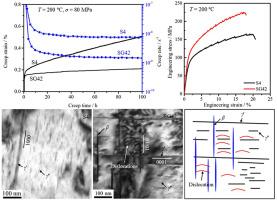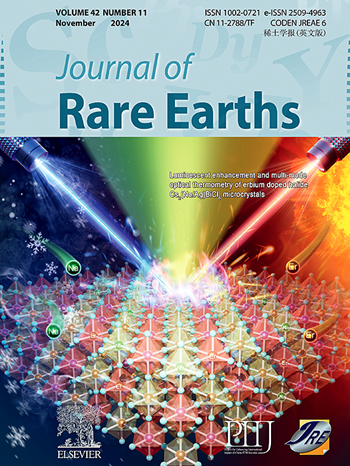添加少量钆提高Mg-Sm-Zn合金的耐热性
IF 7.2
1区 化学
Q1 CHEMISTRY, APPLIED
引用次数: 0
摘要
在Mg-4Sm-0.6Zn-0.4Zr合金中添加少量钆(Gd)可以显著提高合金的高温强度和抗蠕变性能,在200℃下,合金的最小蠕变速率降低了约5倍,屈服强度提高了约40 MPa。Gd的存在导致蠕变过程中柱状β型相和基型γ型相共析出,而无Gd合金中只存在基型γ型相。与单一的基底γ型相相比,棱柱状β型相和基底γ型相在空间上相互垂直,形成一个封闭的结构,有效地阻止了位错运动。因此,富gd合金抗蠕变性能的提高主要归因于蠕变过程中棱柱状β型和γ型相的共析出。此外,稀土(RE)原子本身在高温下提供稳定的溶质硬化,这有助于提高高温强度。Gd的加入还通过促进Mg3RE相的形成来增强晶界稳定性,从而进一步提高蠕变强度。这些发现为开发具有低稀土浓度的高抗蠕变镁合金提供了见解。本文章由计算机程序翻译,如有差异,请以英文原文为准。

Increasing heat resistance of a Mg-Sm-Zn alloy via minor gadolinium addition
The addition of minor gadolinium (Gd) into Mg-4Sm-0.6Zn-0.4Zr alloy significantly enhances high-temperature strength and creep resistance, such as a decrease in the minimum creep rate by approximately five times and an increase in the yield strength by around 40 MPa at 200 °C. The presence of Gd results in the co-precipitation of both prismatic β-type and basal γ-type phases during creep, whereas only the basal γ-type phase is present in the Gd-free alloy. The prismatic β-type and basal γ-type phases are oriented perpendicular to each other in space, creating a closed configuration that effectively blocks dislocation motions compared to single basal γ-type precipitates. Therefore, the improved creep resistance in the Gd-enriched alloy is mainly attributed to the co-precipitation of prismatic β-type and γ-type precipitates during creep. Furthermore, rare earth (RE) atoms inherently provide stable solute hardening at high temperatures, which contributes to the increased high-temperature strength. The addition of Gd also enhances grain boundary stability by promoting the formation of more Mg3RE phases, thereby further enhancing the creep strength. These findings offer insights into the development of highly creep-resistant Mg alloys with low RE concentrations.
求助全文
通过发布文献求助,成功后即可免费获取论文全文。
去求助
来源期刊

Journal of Rare Earths
化学-应用化学
CiteScore
8.70
自引率
14.30%
发文量
374
审稿时长
1.7 months
期刊介绍:
The Journal of Rare Earths reports studies on the 17 rare earth elements. It is a unique English-language learned journal that publishes works on various aspects of basic theory and applied science in the field of rare earths (RE). The journal accepts original high-quality original research papers and review articles with inventive content, and complete experimental data. It represents high academic standards and new progress in the RE field. Due to the advantage of abundant RE resources of China, the research on RE develops very actively, and papers on the latest progress in this field emerge every year. It is not only an important resource in which technicians publish and obtain their latest research results on RE, but also an important way of reflecting the updated progress in RE research field.
The Journal of Rare Earths covers all research and application of RE rare earths including spectroscopy, luminescence and phosphors, rare earth catalysis, magnetism and magnetic materials, advanced rare earth materials, RE chemistry & hydrometallurgy, RE metallography & pyrometallurgy, RE new materials, RE solid state physics & solid state chemistry, rare earth applications, RE analysis & test, RE geology & ore dressing, etc.
 求助内容:
求助内容: 应助结果提醒方式:
应助结果提醒方式:


